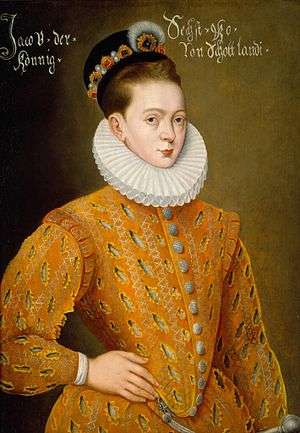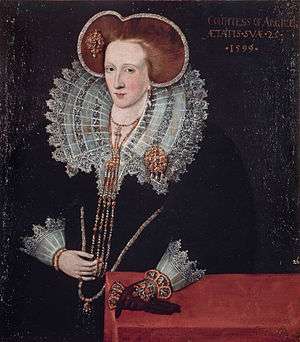Adrian Vanson
Adrian Vanson (died c. 1602) was court portrait painter to James VI of Scotland.

Edinburgh Castle
Adrian was probably born in Breda, the son of Willem Claesswen van Son by Kathelijn Adriaen Matheus de Blauwverversdochter. His uncle Peter Mattheus was a painter in London.[1] In Edinburgh he signed his name "Van Son".[2]
Adrian's first recorded works for James VI in Scotland were two pictures to be sent to Theodore Beza in Geneva, for which he was paid £8-10s in June 1581.[3] These portraits of John Knox and George Buchanan had been sent to Geneva in November 1579 for inclusion as woodcuts in Theodore Beza's Icones (1580), but arrived too late for the book. The woodcuts of Knox and James VI published in Simon Goulart's 1581 edition of the Icones are thought to follow Vanson's portraits. Another woodcut image of George Buchanan, not used in the Icones, but appearing in other works, has been attributed to Arnold Bronckorst.[4]
after Adrian Vanson
Adrian Vanson succeeded Arnold Bronckhorst as "King's painter" in Scotland in May 1584,.[5] His appointment and yearly fee of £100 was confirmed by privy seal letter on 20 August 1584.[6] When he was made a burgess of Edinburgh in December 1585, it was hoped he would teach his craft to apprentices.[7] No records of apprentices, or a workshop have been found. Vanson did not join the Edinburgh craft of Mason and Wrights, which welcomed painter-glaziers.
He may have been 'Lord Seton's painter', who was recorded drawing portraits for coins at the mint in Edinburgh in 1582, to be used by Thomas Foulis.[8] Lord Seton had served as a diplomat and had various European contacts, and his third son John joined the household of the Earl of Leicester in England 1575.[9]
Vanson also painted heraldry on banners for the king's trumpeters, and ceremonial spears and banners and painted the Danish royal arms on banners for the coronation of Anne of Denmark.[10]
Attributed portraits include James VI; Anne of Denmark; Patrick Lyon, Lord Glamis; Sir Thomas Kennedy of Culzean; Agnes Douglas, Countess of Argyll.[11] Vanson's James VI of circa 1585 survives at Edinburgh castle.
In May 1586 a French ambassador in Scotland, the Baron d'Esneval, promised to get Mary, Queen of Scots a copy of a recent portrait of James VI from the only painter in Edinburgh, presumably meaning Vanson.[12] There had been rumours of an embassy to Denmark to discuss the king's marriage in April 1586.[13] It is thought the picture at Edinburgh Castle was made by Vanson for this embassy or a similar purpose.[14] James VI had gold medals with his and Anna of Denmark's portraits made, presumably following patterns by Vanson, and gave one to him worth 20 gold crowns in October 1594.[15]
The execution of Archibald Cornwall in April 1601 for attaching royal portraits to the gallows suggests that pictures of the king and Anne of Denmark were common household objects in Edinburgh.[16]
Adrian was married to Susanna de Colonia, who became an active business woman in Edinburgh, at Dordrecht, on 31 March 1577. Her brother was the portrait painter Adam de Colone. Although the family were of Flemish origin, Vanson's relative or brother Abraham Vanson was also in Edinburgh working as a goldsmith. Their son Adrian was christened on 19 October 1595, the witnesses were the Flemish ambassador Adrian Damman de Bystervelt and Adrian Bowdowingis, a clockmaker. On 21 October 160 Adrian Bowdowingis christened his son Adrian, and Adrian Damman and Adrian Vanson were witnesses.
After Adrian's death, in 1610 Susanna petitioned the king for outstanding payments.[17]
External links

National Galleries of Scotland
- Adrian Vanson at the National Galleries of Scotland
- James VI by Adrian Vanson, at Edinburgh Castle, (Historic Scotland)
- Information on the Edinburgh Castle Vanson from Philip Mould Ltd.
- Margaret Graham by Adam de Colone, National Galleries of Scotland
- James Erskine, 6th earl of Buchan by Adam de Colone, National Galleries of Scotland
- 9 paintings by or after Adrian Vanson at the Art UK site
Footnotes
- Murphy, Nathan W. and Leslie Mahler, "The King, Vanson, and de Colonia Ancestors of William Fitzhugh of Virginia," The American Genealogist, 88 (2016), pp. 152-157.
- Miles Kerr-Peterson & Michael Pearce, 'James VI's English Subsidy and Danish Dowry Accounts, 1588-1596', Scottish History Society Miscellany XVI (Woodbridge, 2020), p. 88.
- Thomson, Duncan, Painting in Scotland (Edinburgh, 1975), 25-26; citing NRS E21//62 f.135v.
- Cameron, J. K., 'Further information on Portraits of George Buchanan', Scottish Historical Review, vol. 42, no. 134, part 2 (Oct. 1963), pp. 135-142: Thomson (1975) does not discuss the Buchanan.
- Thomson, Duncan, Painting in Scotland 1570-1650 (Edinburgh, 1975), p. 25.
- Register of the Privy Seal of Scotland, vol. 8 (Edinburgh, 1982), p. 396 no. 2287.
- Extracts from the records of the burgh of Edinburgh: 1573-1589 (Scottish Burgh Records Society, 1882), p. 446.
- Thomson, Duncan, Painting in Scotland (Edinburgh, 1975), pp. 25, 31: National Records of Scotland, E21/62 f169v.
- Calendar State Papers Scotland, vol. 5 (Edinburgh, 1907), p. 120.
- James Thomson Gibson-Craig, [https://archive.org/details/papersrelative2600geneuoft/page/16 Papers Relative to the Marriage of King James the Sixth of Scotland (Edinburgh, 1836), Appendix p. 16.
- Thomson, Duncan, Painting in Scotland (Edinburgh, 1975), pp. 25-31.
- Strickland, Agnes, Letters of Mary Stuart, vol. 3 (London, 1843), 194: Labanoff, A., vol. 6, 270-1, Mary had asked d'Esneval; "Je vous prie me recouvrer de mon filz ung sien pourtraict en grand, faict sur sa personne propre," Chartley 30 April 1586.
- Calendar State Papers Scotland, vol. 8 (London, 1914), nos. 356, 362, 365.
- See 'information from Philip Mould' in external links.
- Miles Kerr-Peterson & Michael Pearce, 'James VI's English Subsidy and Danish Dowry Accounts, 1588-1596', Scottish History Society Miscellany XVI (Woodbridge, 2020), pp. 83, 88.
- Robert Pitcairn, Ancient Criminal Trials in Scotland vol. 2 part 2 (Edinburgh, 1833), pp.349-351: Calendar State Papers Scotland, vol. 13 part 2 (Edinburgh, 1969), p. 809, 814.
- Apted and Hannabuss, Dictionary of Painters in Scotland (SRS, Edinburgh, 1978), pp. 98-99.
| Preceded by Arnold Bronckorst |
Painter at the Scottish royal court 1581–1602 |
Succeeded by Jacob de Wet |